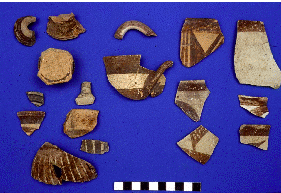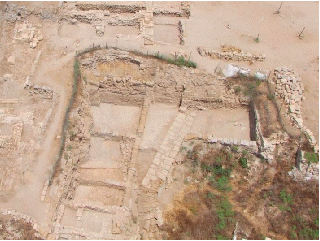By Elizabeth Bloch-Smith
Theological and Religious Studies
Villanova University
January 2009
Iron Age 1a

Located at the southern end of the town, Area D2 fronts the southern bay. Previous excavation proceeded down from ground level to bedrock, up from the Iron 1a to the Roman period. Construction in the area begins in Iron 1a with a wide, fieldstone wall running parallel to the seashore, perhaps an early barrier or “sea wall,” and several phases of fieldstone constructions, apparently residential walls. The earliest quay wall, a massive pavement of flat stones sloping into the southern bay, may also date to this period.
Iron Age 1b

Monumental building begins in Iron 1b. To the west, the so-called “bastion” or “acropolis” wall rings the natural kurkar ridge. To the east, the “monumental building” built of large boulders with ashlars in its corner will remain in use from Iron 1b to 2a and perhaps 2b. To the south, fronting the sea, the “sea wall” stretches between the “bastion” and the “monumental building” as a barrier to keep sea surges from flooding the town. Between the “bastion” and the “monumental building” is a mudbrick-built storage facility with long narrow halls. A wide slab-covered drainage channel separates this building from the “monumental building.” Accompanying material culture providing a date late in Iron 1 includes the earliest “Phoenician Bichrome'” wares and the earliest Cypriot (Cypro-Geometric IA) imports.
Iron Age 2a
The “bastion” or “acropolis” wall, the “monumental building,” and the “sea wall” all continue from Iron 1b into Iron 2a. In the northern part of the area, a modest house replaces the earlier storage facility. Finds from the collapse and rebuildings of this house, including a hoard of silver tokens and early Greek pottery, span the transition from Ir 1 to Ir 2a.
Persian Period
Early in the Persian period, the area serves for industrial activity, indicated by piles of industrial waste generated by iron processing and sherds of hundreds of Assyrian–period storage containers. Later in the period, the area reverts to public use. Buildings with long, narrow halls that may have functioned as harbor storehouses, and the corners of two large public structures fill the space.
Hellenistic and Roman Periods
The area demonstrates continuity through the Hellenistic and Roman periods with Hellenistic houses and the edge of a building of palatial proportions, followed by elegant, Roman residences and industrial installations.
Area D2. 2008 Season

Current excavations in D2 are expanding the previously excavated area to the west. The 2008 season reached remains of the Iron 1b and Iron 2a. The western portion of the excavated area exposed the continuation of the “bastion” with associated stone and mudbrick walls of the Iron 1b acropolis settlement. Evidence of burning, noted in every field thus far excavated, demonstrates that we have reached the Iron 1b, site-wide destruction of the city. Plaster facing preserved on the mudbrick walls and enigmatic stone installations presage well-preserved remains below.
East of the “bastion” the “lower city” was gradually built up so that a monumental ashlar wall of Iron 2a sits at the same elevation as the Iron 1b “bastion” and city remains. The monumental wall, clearly visible in the photograph, is associated with extensive, successive, crushed kurkar resurfacings. These kurkar layers may have covered all of D2 from our wall in the NW part of the area to the corner wall of the “monumental building” in the SE. If these layers are constructional fills, then the ashlar wall likely functioned as a retaining or podium wall for a palatial building that hasn’t survived. Such a building might have been built for Taphath, the daughter King Solomon gave in marriage to Ben-abinadab, the prefect or prince of Naphath-Dor (1 Kings 4:11).
Season dates: July 6 - Aug 12
The field school is run by Prof. Ilan Sharon (Hebrew University) and Dr. Elizabeth Bloch-Smith (St. Joseph's University) through the Hebrew University Rothberg International School. Excavation volunteers may earn 2 credits for 2 weeks participation ($280) or 4 credits for 4 weeks participation ($480), though we recommend staying for a full half (2 and 1/2 weeks) or the entire season (5 weeks). The deadline for applications is May 15, 2009. Register for the dig online at http://dor.huji.ac.il and find information for the accredited program at http://overseas.huji.ac.il/default.asp. For further information contact Dr. Bloch-Smith at eblochsm@sju.edu.
To earn the credits, students must excavate in the morning, process finds in the afternoon, and attend the introductory lectures and museum tour. No experience is necessary; in the field, students will be taught excavation skills, stratigraphy, archaeological method and theory, and basic artifact identification. This season we will dig in the early Iron Age, Phoenician town (ca. 1000 BC) with structures built of mudbrick, and expose a large Iron IIA (ca. 950) Israelite public structure. During the late afternoon hours, when we clean, analyze, record, and store the excavated artifacts, students refine their knowledge of pottery, animal bone, and other small finds. Attendance is optional at the early evening lectures, offered throughout the season, on various aspects of archaeology, history, artifacts, and scientific studies conducted at the site.
Accommodations are at the Kfar Galim boarding school, on the Mediterranean coast, approximately 15 minutes from the site and 5 minutes from the southern end of Haifa. All rooms, accommodating 2-4 persons, are air-conditioned, and each unit has a club-room with TV, coffee making facilities, Internet, refrigerators, and a laundry room.
